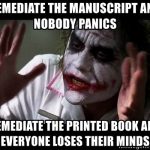New sources of information for students permeates our world. Crowdsourcing is a new buzz-word. Jeff Howe is credited with introducing ‘crowdsourcing’ in an article in Wired in 2006 (Yiu, 2016). With widespread Internet usage in Canada and the US, more and more people are contributing input into intellectual works. In fact, the entire Internet can be considered a crowdsourcing technology. Its existence continues and perpetuates via the cyclical nature of it’s users; both creators and consumers. It is not a new concept. In 1879, the editor of the Oxford English Dictionary, James Murray, had found that using selected readers to source words for their dictionary via academic texts did not reflect the living language of English (“History of the OED” 2017). His solution was to invite contributions from people throughout society to provide samples of everyday-English (“History of the OED”). Interestingly, one of the largest and well-known modern crowd-sourcing projects, Wikipedia, credits the Oxford English Dictionary for being the first to crowdsource for language-related data collection in its own entry on crowdsourcing (Wikipedia, 2018). Crowdsourcing creates challenges for students to evaluate authenticity of their sources and questions the idea of ‘academic authority’. Challenges are created when technology changes the nature of sources of information.
The Internet provides an easier and larger way to undertake crowdsourcing projects. It is very exciting, but we need to consider the potential pitfalls of this advantage. James O’Donnell and James Engell explored the issue of integrating widespread new technologies into society in 1999 during a radio broadcast (Engell & O’Donnell). In the broadcast, O’Donnell and Engell explained that the integration of new technologies results in both positive and negative effects, which O’Donnell illustrated by the exploring the usage of the automobile (Engell & O’Donnell, 1999). In this example, O’Donnell explained how by accepting the benefits of the convenience of the automobile, we are at the same time accepting the loss of life in society via automobile accidents (Engell & O’Donnell). O’Donnell went on to explain that because new technologies always have positive and negative sides, society has a responsibility to seek out the negative effects of new technology and to also mitigate its negative effects (Engell & O’Donnell).
Careful consideration without being swept up in the excitement of new ways of doing things is a mindful and grounding perspective. In Democracy and Education: The Missing Link May Be Ours (2002), John Willinsky wrote about how opening up academic education research to free access via the Internet to the public would have a democratizing impact on society, “…new publishing and broadcasting systems seem bound to reshape both democracy and education, strengthening the link between them.” (Willinsky, p. 18). Willinsky also warned how for both positive and negative effects, public access will result in public input into research design (Willinsky, 2002, p. 14). In a very public exposure, researchers have greater risks to their careers and prestige (Willinsky, p. 17). On the other hand, the research process can benefit from public input (Willinsky, p. 17). I think as responsible educators we need to ask important questions. In the realm of education technology, in a thoughtful way: Have we enhanced the positive aspects and mitigated the negative aspects for our students?
References
Engell, J. (Presenter) & O’Donnell, J. (Presenter). (1999). From Papyrus to Cyberspace [radio broadcast]. Retrieved from https://canvas.ubc.ca/courses/4290/files/609973/preview
History of the OED: Reading program. (2017) Retrieved from https://public.oed.com/history-of-the-oed/reading-programme/
Liu, Y. (2016). Chapter 8: Appeal to the public: Lessons from the early history of the Oxford English Dictionary. Digital Studies/Le champ numérique, 6. DOI: http://doi.org/10.16995/dscn.9
Wikipedia contributors. (2018, May 15). Crowdsourcing. In Wikipedia, The Free Encyclopedia. Retrieved 15:51, May 16, 2018, from https://en.wikipedia.org/w/index.php?title=Crowdsourcing&oldid=841395215
Willinsky, J. (2002). Education and Democracy: The Missing Link May Be Ours. Harvard Educational Review, 72(3), 367-392.




zarah mathai
May 28, 2018 — 12:03 am
This is very relevant question in this digital age of education. This question has come up in several MET courses I have taken, and discussions have always revolved around the balance between digital integration and traditional methods of teaching. In the Cambridge Forum recording, O’Donnell mentions that “the greatest wisdom of all, seems to be in these regards, is to avoid extremism of one form or another” (Engell et al., 1999). I believe O’Donnell’s words continue to ring true even today. The challenge of encouraging digital literacy within the framework of specific curricula is often a daunting one. However, in its implementation, whether educators have enhanced positive aspects of technology and mitigated its negative aspects must be subject to daily reflection. Recognizing that the 21st century student is a digital native in a world where the ubiquity of technology is unquestioned, technology in education must be harnessed with the appropriate strategies to activate and enhance student learning. When employing backwards design, educators have the creative license to have students demonstrate competencies through digital mediums. This requires educators to invest time in lesson planning to ensure effective instructional design considering the immense possibilities of digital integration. Educators must endeavor to implement technological aspects to lessons that allow for more active learning and innovative learning opportunities. Haphazard or impromptu implementation of technology is not only often ineffective, but detrimental to engagement and learning. Furthermore, it is essential that educators recognize the relevance of digital literacy in its cross-curricular importance as a life skill. This form of literacy is not an isolated set of skills, but rather digital education closely correlates to creative and collaborative capacities. I believe that with this level of consideration, technology can enhance and diversify the learning experience while mitigating any potentially negative impacts to student learning.
References
Engell J. & O’Donnell J. (1999). From Papyrus to Cyberspace. [Audio File]. Cambridge Forums. Retrieved from https://canvas.ubc.ca/courses/4290/files/609973/preview